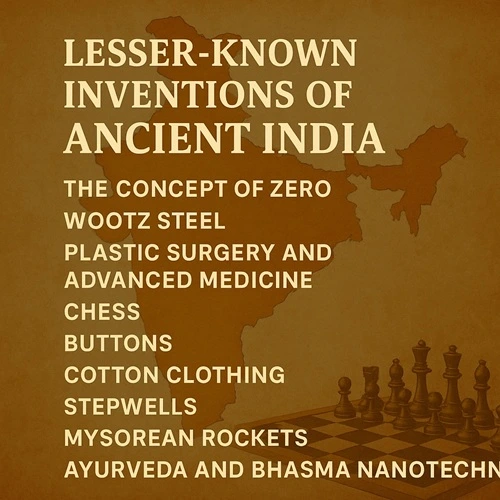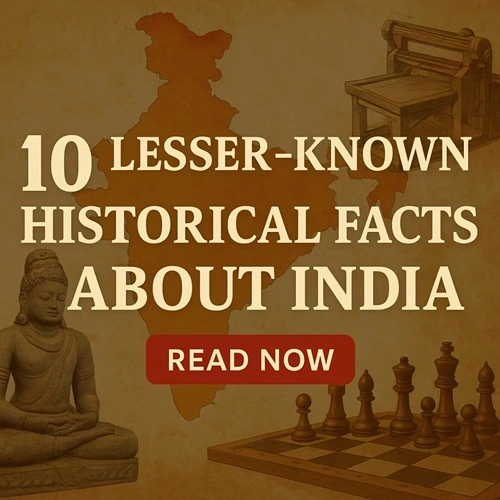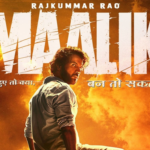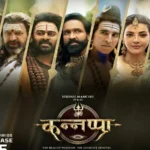When most people think of India’s past, the first images that come to mind are grand temples, mighty kings, colorful traditions, and spiritual wisdom. But beyond the palaces and prayers, India also has a fascinating legacy of scientific brilliance and innovation that continues to shape our modern world.
From mathematics and medicine to metallurgy and strategy games, ancient Indian minds were far ahead of their time. In fact, many things we take for granted today, whether it’s the concept of zero, surgical techniques, or even everyday objects like buttons, were pioneered in India centuries, sometimes millennia, ago.
So, let’s take a journey through history and uncover 10 lesser known inventions of ancient India that truly changed the world.

10 lesser known inventions of ancient India Are :
1. The Concept of Zero – India’s Greatest Gift to the World
Imagine trying to do math without zero. No calculators, no modern computers, no financial systems as we know them today. The concept of zero revolutionized mathematics, and it was born in India.
While early civilizations used placeholders, it was Aryabhata (5th century CE) and later Brahmagupta (7th century CE) who defined zero as a number with its own value and rules. This breakthrough laid the foundation for the decimal system, algebra, and all advanced mathematics.
Without zero, modern computing and digital technology would be impossible. Every “0” and “1” in binary code that powers your smartphone today owes its existence to this ancient Indian invention.
2. Wootz Steel – The Secret Behind Legendary Swords
Long before Europe mastered metallurgy, India had already developed a high quality steel known as Wootz steel around 300 BCE. Produced mainly in South India (Tamil Nadu, Karnataka, and Kerala), this steel was famous for its durability and sharpness.
It was so sought after that it was exported across the world, from Rome to the Middle East and even China. The world famous Damascus swords, known for their strength and distinctive patterns, were made using Wootz steel imported from India.
Modern metallurgists still study this ancient technique because Wootz steel had properties similar to nanotechnology in carbon structures, way ahead of its time.
3. Plastic Surgery and Advanced Medicine
When we talk about ancient medicine, Ayurveda immediately comes to mind. But India also pioneered surgical science. The Sushruta Samhita, written around 600 BCE by the physician Sushruta, is considered one of the oldest surgical textbooks in the world.
This text described:
- Rhinoplasty (nose reconstruction) using skin grafts
- Cataract surgery
- Dental extractions
- Treatment of fractures and wounds
- 300+ surgical procedures and 120+ surgical instruments
It’s fascinating to think that while much of the world still relied on spiritual healing or trial and error methods, Indian physicians were already performing complex operations with precision.
4. Chess – The Game of Kings
The next time you sit down for a game of chess, remember that it has Indian roots. The game was originally called Chaturanga, dating back to the Gupta Empire (around 6th century CE).
Chaturanga means “four divisions of the military” , infantry, cavalry, elephants, and chariots, represented by pawns, knights, bishops, and rooks in modern chess. The game spread to Persia (where it became Shatranj), then to the Arab world, and eventually to Europe, where it evolved into the chess we know today.
Chess wasn’t just entertainment; it was a strategic training tool for kings and warriors, teaching them planning, patience, and foresight.
5. Buttons and Cotton Clothing
Yes, something as ordinary as a button has its origins in India. Archaeologists have discovered seashell buttons with holes, dating back to the Indus Valley Civilization (2000 BCE). Initially decorative, they eventually became functional fasteners.
India was also the first to grow and weave cotton, producing soft, comfortable textiles when much of the world still used animal hides or coarse fabrics. Indian cotton became so popular that Greek historians like Herodotus wrote about “wool growing on trees.”
Even today, India remains a global leader in cotton textiles, a tradition that started thousands of years ago.
6. Stepwells – India’s Ingenious Water Conservation System
Water scarcity is a modern crisis, but ancient India had already devised sustainable solutions centuries ago. Stepwells (locally called Baolis or Vavs) were unique structures that combined water storage, architecture, and social gathering spaces.
Examples include:
- Chand Baori in Rajasthan — one of the deepest stepwells in the world with 3,500 steps.
- Rani Ki Vav in Gujarat — a UNESCO World Heritage Site, designed as an inverted temple dedicated to water.
These stepwells not only conserved water in arid regions but also showcased intricate carvings and temple like designs, proving India’s ability to merge utility with beauty.
7. Mysorean Rockets – India’s Military Innovation
When we think of rockets, NASA or SpaceX usually come to mind. But did you know that India’s Mysorean rockets were among the earliest iron cased rockets used in warfare?
In the late 18th century, Tipu Sultan and his father Hyder Ali developed rocket artillery that could travel long distances and cause significant damage. These rockets were used effectively against the British forces.
Impressed (and alarmed), the British later reverse engineered these designs, leading to the development of the Congreve rockets in Europe. In a way, modern rocketry owes a debt to India’s Mysorean innovation.
8. Ayurveda and Bhasma Nanotechnology
Ayurveda, India’s ancient medical system, is well known globally. But what’s less known is its use of nanotechnology like practices thousands of years ago.
Ayurvedic texts describe the preparation of Bhasma, fine ash derived from metals like gold, silver, copper, and mercury. These ashes were processed into nano sized particles that could be easily absorbed by the body for medicinal purposes.
Modern research has confirmed that some Ayurvedic formulations contain particles at the nano scale, making Ayurveda not just ancient wisdom but a science ahead of its time.
9. Panini’s Sanskrit Grammar – The Blueprint of Language
Around 500 BCE, the scholar Panini wrote the Ashtadhyayi, a detailed treatise on Sanskrit grammar. This wasn’t just any grammar book, it was a highly logical, rule based system with almost algorithmic precision.
Panini’s work is so advanced that modern linguists and even computer scientists have compared it to programming languages. In fact, his methods have influenced natural language processing (NLP) in Artificial Intelligence.
So next time you use Google Translate or chat with AI, remember, a seed of that linguistic logic was planted in India thousands of years ago.
10. Cataract Surgery and Dentistry
While we’ve already spoken about Sushruta’s contributions, it’s worth highlighting two specific areas: cataract surgery and dentistry.
- Cataract surgery was performed by using a curved needle to remove the lens, a technique that influenced later practices in Greece and beyond.
- Ancient Indian texts also mention dental treatments, including the use of natural substances for fillings and cleaning teeth.
It’s fascinating to realize that medical knowledge we consider “modern” was already practiced in India centuries ago.
10 lesser known inventions of ancient India Conclusion: India’s Legacy of Innovation
India’s past is a treasure chest filled not just with spiritual wisdom and cultural heritage but also with groundbreaking scientific contributions. From zero to rockets, from surgery to steel, ancient Indians were true pioneers whose work silently shaped the course of global progress.
Yet, many of these contributions remain underappreciated outside history books. Recognizing them isn’t just about pride, it’s about acknowledging the depth of human creativity that existed long before modern labs and factories.
So the next time you calculate with zero, wear a cotton shirt, or play a game of chess, remember, you are experiencing the genius of ancient India in your daily life.

Hi, I’m Prashant Jain — a curious soul, storyteller, and content creator at heart.I’ve always been drawn to the world of entertainment, travel, sports, health & lifestyle — not just as a writer, but as someone who genuinely lives these experiences. Whether I’m binge-watching the latest OTT series, exploring offbeat spiritual destinations in India, or diving deep into wellness routines and cricket match insights, I love sharing what I discover with like-minded readers.
PopNewsBlend is my way of blending personal journeys with meaningful stories — ones that inform, inspire, and keep you ahead of the curve. Everything I write comes from real observations, hands-on experiences, and a deep passion for understanding the world around us.
Discover more from Popnewsblend
Subscribe to get the latest posts sent to your email.







